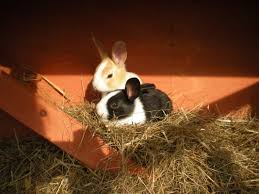Everything You Need To Know About Dutch Rabbit
The Dutch rabbit is one of the mature rabbit breeds. It is also the most popular rabbit breed everywhere in the world. The specific origin of the Dutch rabbit is not clear. Some people say the breed began in England in the mid of the 19th century. Others say it was founded in the Netherlands and was founded in England in 1864. Probably it is decreased from the Petite Brabacon (which was bred in large numbers for the meat trade during the 19th century) from the Brabant region in Flanders. The variety is also known as Brabander or Hollander. Dutch rabbit is a small breed, but it is not a dwarf rabbit variety. It was once the most famous of all rabbit breeds.
But after the improvement of the dwarf rabbits, the popularity of this breed decreased. Although the Dutch rabbit is still one of the top most popular rabbit breeds throughout the world. This breed is accepted by British Rabbit Council (BRC) and the American Rabbit Breeders Association (ARBA). Today, the Dutch rabbit is a popular breed for show and also grown as a pet. Some of the varieties of these Dutch rabbit breeds are Dutch dwarf rabbit, Blue Dutch rabbit, Black Dutch rabbit, Chocolate Dutch rabbit, Dutch Lop rabbit, and Dutch belted rabbit. Let’s take a look at this description of breed origin below.
Do Dutch Rabbits Make Good Pets?
 Dutch Rabbits are friendly, with warm natures. They can be very active and use enough space to run off vapor. Many owners enjoy practicing their rabbits, and this can be a great bonding exercise. Rabbits can learn to come when called, complete obstacle courses, and more. Care must be given when handling your rabbit, as with other rabbits. Dutch Rabbits are known for their considerate type and kind character.
Dutch Rabbits are friendly, with warm natures. They can be very active and use enough space to run off vapor. Many owners enjoy practicing their rabbits, and this can be a great bonding exercise. Rabbits can learn to come when called, complete obstacle courses, and more. Care must be given when handling your rabbit, as with other rabbits. Dutch Rabbits are known for their considerate type and kind character.
Dutch Rabbit makes them well adapted to being kept as a family pet. While bunnies look cuddly, some don’t enjoy being picked up and may panic if pulled by someone who doesn’t know how to handle them well. If dropped, this can damage your rabbit’s fragile bones. Many families decide to create a large outdoor run for their rabbits, in which family parts can interact with bunnies without picking them up. Other families let their rabbits free run of the house.
What Does Dutch Rabbit Eat?
 The most food for rabbits is hay. Fresh hay and freshwater are two things rabbits must-have free entrance to at all times. The type of hay things. For healthy grown-up rabbits who aren’t nursing, fresh grass hay laws. This hay includes Timothy, orchard, oat, and other grass hays. Young rabbits, nursing mothers, or infected rabbits need the added calories, extra protein, and calcium of alfalfa hay. Hay is the main for rabbits because eating it provides a wonderful way for rabbits to wear down their continually growing teeth. This hay can prevent some dental problems. About 70 percent or more of a rabbit’s regular food should be hay.
The most food for rabbits is hay. Fresh hay and freshwater are two things rabbits must-have free entrance to at all times. The type of hay things. For healthy grown-up rabbits who aren’t nursing, fresh grass hay laws. This hay includes Timothy, orchard, oat, and other grass hays. Young rabbits, nursing mothers, or infected rabbits need the added calories, extra protein, and calcium of alfalfa hay. Hay is the main for rabbits because eating it provides a wonderful way for rabbits to wear down their continually growing teeth. This hay can prevent some dental problems. About 70 percent or more of a rabbit’s regular food should be hay.
Besides hay, bunnies enjoy eating leafy greens and vegetables. Fruit is also appreciated, but the sugar content suggests you must offer only small servings. Consider vegetables and fruit as treats. You don’t want your rabbit choosing up on these and not eating enough hay. Ask your veterinarian about which vegetables and fruits are supported and safe for rabbits to have. Some that are safe for people can harm rabbits. A pelleted food formulated especially for rabbits is a small but main part of the rabbit diet. This pellet provides vitamins and minerals that are missing.
How Big Is A Dutch Rabbit?
The Dutch rabbit is a small breed that is easily confused for a dwarf breed of rabbits. However, it is not. The size of various rabbits depends on the rabbit itself and the living conditions within which it was raised. The ideal weight range of a grown Dutch rabbit is between 3.5 and 5.5 pounds. Thus, you have a more specific idea of how big your Dutch rabbit would go by the sixth month.
Is Dutch Rabbit Rabbit Aggressive?
 Naturally, Dutch rabbits are not aggressive. That means they wouldn’t bite you unprovoked. But, as it is intrinsic to most animals, rabbits bite as well, however very infrequently. When a rabbit bites you, 85 percent of the time, it is in a protecting mode when it perceives you as an acute threat. Dutch rabbits are some of the friendliest and most domestic animals you can find nearby. They simply and easily bond with people. There are some conditions a Dutch rabbit may force to bite you. Generally, these injuries are harmless, you can be sure there will be no medical difficulties arising from them so long the bite is not affected. Admittedly, the bites from this beautiful creature hurt. While they could suffer, the majority of such bites are superficial skin cuts and lack depth.
Naturally, Dutch rabbits are not aggressive. That means they wouldn’t bite you unprovoked. But, as it is intrinsic to most animals, rabbits bite as well, however very infrequently. When a rabbit bites you, 85 percent of the time, it is in a protecting mode when it perceives you as an acute threat. Dutch rabbits are some of the friendliest and most domestic animals you can find nearby. They simply and easily bond with people. There are some conditions a Dutch rabbit may force to bite you. Generally, these injuries are harmless, you can be sure there will be no medical difficulties arising from them so long the bite is not affected. Admittedly, the bites from this beautiful creature hurt. While they could suffer, the majority of such bites are superficial skin cuts and lack depth.
What’s The Average Lifespan Of A Dutch Rabbit?
Dutch rabbits have the ideal living situation and are well cared for, Dutch rabbits can live for anywhere between 5 and 8 years. The average lifespan of a Dutch rabbit is around 5 years. A Dutch rabbit can also survive 15 years. The determinants of the duration your Dutch rabbit would breathe are its diet, housing (and hygiene conditions), and owner’s concern.
How Fast Does Dutch Rabbit Grow?
The Dutch rabbits are fast-growing pets, they can be sexually mature between 2 and 3 months of age when accurately fed.
How Do You Bond With A Dutch Rabbit?
 Rabbits are friendly animals. They need bonds to thrive. One of the most valuable relationships a rabbit will ever have is with its caregiver. This relationship will learn the quality of a rabbit’s personality. Speak softly. Those huge ears are good at bearing sound. Rabbits look to use listening to people, as long as your voice is soft and gentle. Let your rabbit approach you. Rabbits are naturally unique. If you are quiet, she will come over and inspect you. Let her explore and learn that you are not a predator. Give a few small treats as you are going to know each other. Eating is a social activity for rabbits else eating together builds belief. Small portions of carrot, apple, or oats are offerings a rabbit will enjoy.
Rabbits are friendly animals. They need bonds to thrive. One of the most valuable relationships a rabbit will ever have is with its caregiver. This relationship will learn the quality of a rabbit’s personality. Speak softly. Those huge ears are good at bearing sound. Rabbits look to use listening to people, as long as your voice is soft and gentle. Let your rabbit approach you. Rabbits are naturally unique. If you are quiet, she will come over and inspect you. Let her explore and learn that you are not a predator. Give a few small treats as you are going to know each other. Eating is a social activity for rabbits else eating together builds belief. Small portions of carrot, apple, or oats are offerings a rabbit will enjoy.
Hold your rabbit well. And show in mind that rabbits usually dislike being taken. Rabbits are ground-dwelling creatures who naturally fear being lifted from the ground by predators. Lifting and holding should be kept to the lowest. Although they don’t like to be picked up, most bunnies do love physical affection. Most get petted, cuddling, nuzzling, and sitting companionably with each other with some activities.
Final Thought
The Dutch rabbit is a tiny, friendly breed with a fabulous character and a pretty coat. Gentle and warm, these bunnies make a unique family pet, especially for those with children. The Dutch are active and active, keeping you on your toes and having you entertained. You have to make sure this bun has enough time outside of their hutch, they can become bored and fall, but as long as they’re exercising daily and get lots of concentration, they’ll be your best friend.
https://www.rabbitproducersassociation.com/dutch-rabbit/https://www.rabbitproducersassociation.com/wp-content/uploads/2021/07/Dutch-Rabbit-1024x982.jpghttps://www.rabbitproducersassociation.com/wp-content/uploads/2021/07/Dutch-Rabbit-150x150.jpgUncategorizedThe Dutch rabbit is one of the mature rabbit breeds. It is also the most popular rabbit breed everywhere in the world. The specific origin of the Dutch rabbit is not clear. Some people say the breed began in England in the mid of the 19th century. Others say...FizleenFizleen fizleenmazlanx@gmail.comAuthorNetherland Dwarf Rabbit


Leave a Reply